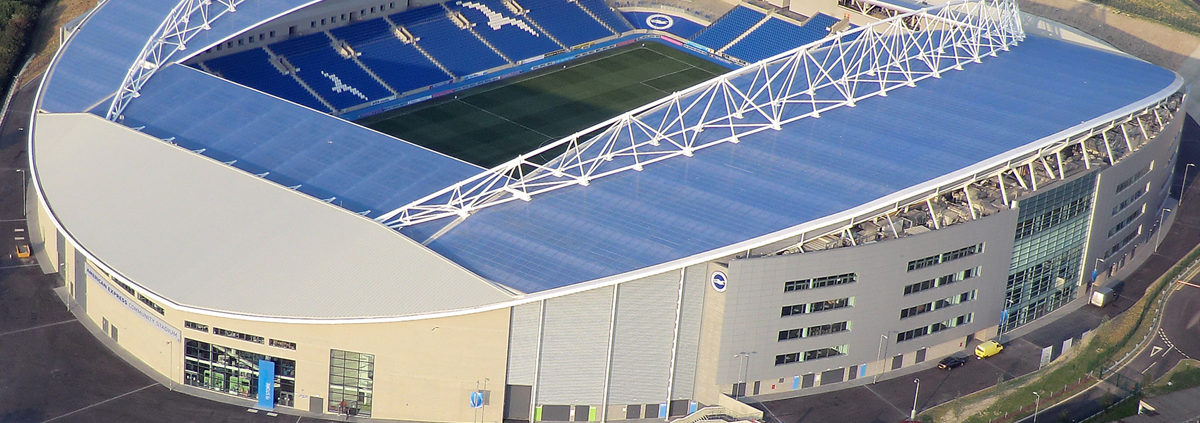GROUNDSMAN ON A MISSION
 In a Turf Matters exclusive, Leicester City FC grounds manager John Ledwidge, speaks openly about his iconic pitch designs, raising the profile of the industry and hits back against the criticism.
In a Turf Matters exclusive, Leicester City FC grounds manager John Ledwidge, speaks openly about his iconic pitch designs, raising the profile of the industry and hits back against the criticism.
In one of the greatest sporting stories of all time, Leicester City were crowned champions of the 2015/16 Premier League title. However it was not just the players that received all the plaudits – the level of groundsmanship put into the pitch at the King Power Stadium certainly matched the efforts of the team itself. In fact, John Ledwidge and his team’s pitch designs and artistry week on week, amazed both fans and media across the country and beyond.
Social Media became a frenzy with delighted spectators praising the intricate designs – with some calling for John to receive a knighthood; one Twitter user posted a Tweet which read, “Forget Vardy, Mahrez and Kante – the head groundsman at Leicester is the real hero of their season”; another claimed that the groundsmen were a “group of artists and the pitch had been their canvas all season.”; while one disgruntled Manchester United fan believed that it was “Sad how the Leicester City ground staff have more creativity than the entire United team.”
“It was a fairytale story for all concerned and we were part of that,” says John. “For me I felt that it presented an ideal marketing opportunity. We’re on the biggest stage in the world in the Premier League, we’re at the top of the league, and we’re making this fairytale story so why shouldn’t groundsmanship be part of that? We got a mention in the New York Times recently, and the fact that groundsmanship is being recognised within a published article about the club and its successful season – is great in my opinion.”
It’s hard to disagree with – without groundsmen the players wouldn’t have their stage to perform on in front of millions of adoring fans. It is also worth considering the amount of work that goes into these pitches to ensure that multi-million pound players can complete a 90 minute game on a safe surface. Holidays and time off is somewhat of rarity in the groundsmanship industry. More than often, groundsmen are the first to enter the premises in the morning dusk and the last to leave as daylight is fading. Then there is Christmas to consider – while most of us are wrapped up warmly in dressing gowns and slippers opening presents with our loved ones, the majority of groundsmen will be out in the frost preparing pitches for the notorious Boxing Day fixtures.
Therefore, it seems onl y right that groundsmanship is commended and recognised as part of the beautiful game. However, for all the positive comments about Leicester City’s pitch designs, there has also been crumbs of negativity – mainly from fellow groundsmen. Their main gripe was in suggesting that John has too much time on his hands and that perhaps the grounds team are over staffed. Others suggested that it might put un-necessary pressure on groundsmen to produce the same kind of pitch designs and there were some who even claimed that it could cause a hindrance to referees and linesmen.
y right that groundsmanship is commended and recognised as part of the beautiful game. However, for all the positive comments about Leicester City’s pitch designs, there has also been crumbs of negativity – mainly from fellow groundsmen. Their main gripe was in suggesting that John has too much time on his hands and that perhaps the grounds team are over staffed. Others suggested that it might put un-necessary pressure on groundsmen to produce the same kind of pitch designs and there were some who even claimed that it could cause a hindrance to referees and linesmen.
“The pitch designs have had more negativity within our own industry which I found really surprising,” says John. “I believe that the pitch has been in good condition and it consistently was throughout last season when we were doing the designs. My lads are a creative bunch and if the main core of the pitch is in good shape then I have no objections at all to patterns. It’s got people talking about the industry and that was always the goal.”
“The goal isn’t about me and it isn’t about the football club – it’s about putting groundsmanship on more of a platform and you only have to look at the media coverage that we received to see that it did its job. What I didn’t want it to be was a “look at me” exercise, I wanted it to showcase what a groundsman is capable of. I saw the opportunity for us to market ourselves and market groundsmanship on the back of the team’s success, and surely that’s just forward thinking.”
“People are quick to moan about salaries and this and that but if we don’t have a presence in the media and have people talking about us – then things will never change.”
According to The Guardian, the average salary for a Groundsman is £17,061 per year, which some would suggest is incredibly low for the amount of work that goes into groundsmanship. Mark Perrin, former head groundsman of Crystal Palace once said, “If I had £1 for every time someone asked me if I just watch the games and cut the grass, I’d be worth a fortune.”
Of course, ensuring that the pitch is playable remains the main task, including renovations each summer whic h is not helped by the club holding hospitality events on it as well as pre-season friendlies. Then there are also plenty of other integral jobs which include keeping the grass the correct length, watering and rolling it, and ensuring it doesn’t freeze or dry out. The job is as much about turf nutrition as it is anything else. Groundsmen need to have the ability to know when and what fertiliser to use, aeration, microbial activity and grass seeds – to name but a few. Unfortunately Mark Perrin’s comment hits the nail on the head and perhaps more work is needed to show that being a groundsman is as much about being a scientist as he is a ‘grass-cutter.’
h is not helped by the club holding hospitality events on it as well as pre-season friendlies. Then there are also plenty of other integral jobs which include keeping the grass the correct length, watering and rolling it, and ensuring it doesn’t freeze or dry out. The job is as much about turf nutrition as it is anything else. Groundsmen need to have the ability to know when and what fertiliser to use, aeration, microbial activity and grass seeds – to name but a few. Unfortunately Mark Perrin’s comment hits the nail on the head and perhaps more work is needed to show that being a groundsman is as much about being a scientist as he is a ‘grass-cutter.’
“We need to push ourselves more,” argues John. “Although patterns aren’t necessarily pushing ourselves more, because people have been doing it way before me and people will long continue to do it after I’ve finished my career, but the fact of the matter is that we have to think of ways to make people talk about what we do in a positive way.”
“Behind all the patterns, and what people may consider as showmanship, is a lot of hard work – a lot of pumping the message to a lot of people about groundsmanship and the patterns have opened the door for me to do that and to champion groundsmanship. In turn it has gained more respect, gained more professionalism and over time, hopefully it will put us on a platform where people are willing to pay us more money.”
“If all these little things help the cause then we will continue to go and put patterns on the pitch. Sometimes if we’ve had a lot of games then we might not have the time to do it, but if we can then why not?”
“I think some people think that I’ve made it harder work for them, but I always think it is how you look at situations. Some people will say ‘“we’re at a local authority or a school and we want a pitch like Leicester’s.”’ For me, that isn’t a bad thing because then I’d go and say that “to get a pitch like Leicester’s you need to give me some more money,” and therefore can you invest in some money for your department and if that extra money gets you drainage work or some feed then it’s had a positive effect.”
“The bottom line is, we put a pattern on the pitch and people think it looks good which helps when you ask for more budget. If that’s what it takes to get the money then so be it. It’s worked here because year on year, we’ve had substantial investment. Since I’ve come in we’ve spent over £3m on constructing pitches at the training ground, we’ve spent over half a million on machinery and we’ve restructured the whole department, we’ve put a new organisational structure in and everyone’s had a pay rise. So is it working? You ask yourself the question.
“I’m not saying it’s all because of patterns – what I’m saying is that all these things contribute to us being held in a higher regard. I don’t do it for me, I do it for the department and then in turn, do it for the industry.”
department and then in turn, do it for the industry.”
“Groundsmanship in this country is held in very high regard all over the world, regardless of pitch patterns, but I think it’s been escalated by what we did last year and the media coverage we received. If the team hadn’t have won the league, maybe we wouldn’t have had as much coverage but even still I think there’d have been an escalation of interest.”
“I think the problem is, that a lot of groundsmen don’t have that attribute of seeing an opportunity and seizing it and in turn raising the profile of the industry. When you’re portraying yourself in public you need to put the best foot forward so that you create an image and a reputation for yourself and the industry that’s going to make us better.”
Some will agree, some may not, but one thing is certain – John is extremely passionate about the industry he works in. From facilitating educational days for school children to working alongside the Young IOG (Institute of Groundsmanship) board of directors in encouraging young people into the industry – John is a proud and pro-active groundsman.
It is inevitable that some will point to showmanship. If ever there was a case of a celebrity groundsman then John fits the bill – aside from a large social media following, the public are starting to point and recognise John as he walks the high streets of Leicester. Although autographs and ‘selfies’ are not, as of yet, part and parcel of his role, how much of this new found fame plays a part in John’s pitch patterns?
“Of course there is always an element of wanting to put myself and my team on the map – I’m ambitious and so are the guys I work with,” says John. “Ultimately I am doing it for the greater good: it’s not about me, it’s about all of us.”
“I think the more that groundsmanship evolves, the more we need to drag ourselves out the doldrums of years gone by and push ourselves into the 21st century. We need to realise that we’ve got to capitalise on opportunities that are put in front of us, and not sit there moaning about what everyone else is doing around us.”



 We look at the development of the all-purpose, multi-use stadium, and how they have become part of the fabric of modern day society.
We look at the development of the all-purpose, multi-use stadium, and how they have become part of the fabric of modern day society. Organised by Bob Geldoff, acts including Queen, U2, Phil Collins, David Bowie, Paul McCartney and The Who. It was the first of what has become many charity inspired music events all over the world which have raised millions for diverse causes.
Organised by Bob Geldoff, acts including Queen, U2, Phil Collins, David Bowie, Paul McCartney and The Who. It was the first of what has become many charity inspired music events all over the world which have raised millions for diverse causes. From day one the Olympic Park showed its versatility with the mind blowing 2012 Opening Ceremony, complete with giant chimney stacks and parachuting monarchs, preparing the way for Usain Bolt and his colleagues to showcase their sporting prowess to the world. With spectator seats equipped with flashing lights a stadium is now expected to play a full interactive role in proceedings and the Olympic Park did that.
From day one the Olympic Park showed its versatility with the mind blowing 2012 Opening Ceremony, complete with giant chimney stacks and parachuting monarchs, preparing the way for Usain Bolt and his colleagues to showcase their sporting prowess to the world. With spectator seats equipped with flashing lights a stadium is now expected to play a full interactive role in proceedings and the Olympic Park did that. Every part of the county is now catered for and the names, if not exactly tripping off the tongue, becoming more and more familiar to us. The Riverside Stadium; The Ricoh Arena; The Amex Stadium; the Macron Stadium; the Vitality Stadium; the Ipro Stadium; the Keepmoat Stadium; the KC Stadium’ the King Power Stadium; the Ethiad Stadium; the Kassam Stadium; St Mary’s Stadium; the Britannia Stadium; the Stadium of Light and the DW Stadium are just a few, and all in England. Add to that those in other parts of the UK – Murrayfield, in Edinburgh, to name but one – and add in the cricket grounds which are now authentic options for rock concerts and, in the case of Lords, wonderful archery venues, and you have a plethora of multi-use venues which didn’t exist 20 years ago (excluding Lords, of course!).
Every part of the county is now catered for and the names, if not exactly tripping off the tongue, becoming more and more familiar to us. The Riverside Stadium; The Ricoh Arena; The Amex Stadium; the Macron Stadium; the Vitality Stadium; the Ipro Stadium; the Keepmoat Stadium; the KC Stadium’ the King Power Stadium; the Ethiad Stadium; the Kassam Stadium; St Mary’s Stadium; the Britannia Stadium; the Stadium of Light and the DW Stadium are just a few, and all in England. Add to that those in other parts of the UK – Murrayfield, in Edinburgh, to name but one – and add in the cricket grounds which are now authentic options for rock concerts and, in the case of Lords, wonderful archery venues, and you have a plethora of multi-use venues which didn’t exist 20 years ago (excluding Lords, of course!).

 When it got to February with no improvement Billy and his team decided that drastic times required drastic measures and they started pumping.
When it got to February with no improvement Billy and his team decided that drastic times required drastic measures and they started pumping. “He has been here on a number of occasions and has gone on the official course walks to see how preparations are progressing.”
“He has been here on a number of occasions and has gone on the official course walks to see how preparations are progressing.” Speaking six weeks before the first tee shot is hit in the Open, Billy was deep in preparation mode and keen to ensure every base was covered.
Speaking six weeks before the first tee shot is hit in the Open, Billy was deep in preparation mode and keen to ensure every base was covered.






